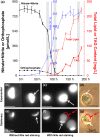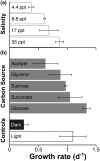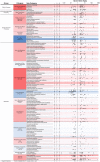Use of De Novo Transcriptome Libraries to Characterize a Novel Oleaginous Marine Chlorella Species during the Accumulation of Triacylglycerols
- PMID: 26840425
- PMCID: PMC4740408
- DOI: 10.1371/journal.pone.0147527
Use of De Novo Transcriptome Libraries to Characterize a Novel Oleaginous Marine Chlorella Species during the Accumulation of Triacylglycerols
Abstract
Marine chlorophytes of the genus Chlorella are unicellular algae capable of accumulating a high proportion of cellular lipids that can be used for biodiesel production. In this study, we examined the broad physiological capabilities of a subtropical strain (C596) of Chlorella sp. "SAG-211-18" including its heterotrophic growth and tolerance to low salt. We found that the alga replicates more slowly at diluted salt concentrations and can grow on a wide range of carbon substrates in the dark. We then sequenced the RNA of Chlorella strain C596 to elucidate key metabolic genes and investigate the transcriptomic response of the organism when transitioning from a nutrient-replete to a nutrient-deficient condition when neutral lipids accumulate. Specific transcripts encoding for enzymes involved in both starch and lipid biosynthesis, among others, were up-regulated as the cultures transitioned into a lipid-accumulating state whereas photosynthesis-related genes were down-regulated. Transcripts encoding for two of the up-regulated enzymes-a galactoglycerolipid lipase and a diacylglyceride acyltransferase-were also monitored by reverse transcription quantitative polymerase chain reaction assays. The results of these assays confirmed the transcriptome-sequencing data. The present transcriptomic study will assist in the greater understanding, more effective application, and efficient design of Chlorella-based biofuel production systems.
Conflict of interest statement
Figures





Similar articles
-
Genomic Foundation of Starch-to-Lipid Switch in Oleaginous Chlorella spp.Plant Physiol. 2015 Dec;169(4):2444-61. doi: 10.1104/pp.15.01174. Epub 2015 Oct 20. Plant Physiol. 2015. PMID: 26486592 Free PMC article.
-
The effect of nutrition pattern alteration on Chlorella pyrenoidosa growth, lipid biosynthesis-related gene transcription.Bioresour Technol. 2014 Jul;164:214-20. doi: 10.1016/j.biortech.2014.04.087. Epub 2014 May 9. Bioresour Technol. 2014. PMID: 24859213
-
Oil accumulation mechanisms of the oleaginous microalga Chlorella protothecoides revealed through its genome, transcriptomes, and proteomes.BMC Genomics. 2014 Jul 10;15(1):582. doi: 10.1186/1471-2164-15-582. BMC Genomics. 2014. PMID: 25012212 Free PMC article.
-
Elevated CO2 improves lipid accumulation by increasing carbon metabolism in Chlorella sorokiniana.Plant Biotechnol J. 2016 Feb;14(2):557-66. doi: 10.1111/pbi.12398. Epub 2015 May 14. Plant Biotechnol J. 2016. PMID: 25973988 Free PMC article.
-
Physiological evaluation of a new Chlorella sorokiniana isolate for its biomass production and lipid accumulation in photoautotrophic and heterotrophic cultures.Biotechnol Bioeng. 2012 Aug;109(8):1958-64. doi: 10.1002/bit.24477. Epub 2012 Mar 2. Biotechnol Bioeng. 2012. PMID: 22354808
Cited by
-
Transcriptional insights into Chlorella sp. ABC-001: a comparative study of carbon fixation and lipid synthesis under different CO2 conditions.Biotechnol Biofuels Bioprod. 2023 Jul 15;16(1):113. doi: 10.1186/s13068-023-02358-4. Biotechnol Biofuels Bioprod. 2023. PMID: 37454088 Free PMC article.
-
A downstream box fusion allows stable accumulation of a bacterial cellulase in Chlamydomonas reinhardtii chloroplasts.Biotechnol Biofuels. 2018 May 10;11:133. doi: 10.1186/s13068-018-1127-7. eCollection 2018. Biotechnol Biofuels. 2018. PMID: 29760775 Free PMC article.
-
Molecular basis of autotrophic vs mixotrophic growth in Chlorella sorokiniana.Sci Rep. 2018 Apr 24;8(1):6465. doi: 10.1038/s41598-018-24979-8. Sci Rep. 2018. PMID: 29691462 Free PMC article.
-
De novo transcriptome and lipidome analysis of Desmodesmus abundans under model flue gas reveals adaptive changes after ten years of acclimation to high CO2.PLoS One. 2024 May 17;19(5):e0299780. doi: 10.1371/journal.pone.0299780. eCollection 2024. PLoS One. 2024. PMID: 38758755 Free PMC article.
References
-
- Williams PJlB, Laurens LML. Microalgae as biodiesel & biomass feedstocks: Review & analysis of the biochemistry, energetics & economics. Energy and Environmental Science. 2010;3:554–590. 10.1039/b924978h - DOI
-
- Zhu L. Biorefinery as a promising approach to promote microalgae industry: An innovative framework. Renewable and Sustainable Energy Reviews. 2015;41:1376–1384. 10.1016/j.rser.2014.09.040 - DOI
-
- Volkman J, Jeffrey S, Nichols P, Rogers G, Garland C. Fatty acid and lipid composition of 10 species of microalgae used in mariculture. Journal of Experimental Marine Biology and Ecology. 1989;128(3):219–240. 10.1016/0022-0981(89)90029-4 - DOI
-
- Sheehan J, Dunahay T, Benemann J, Roessler P. A look back at the US Department of Energy’s aquatic species program: biodiesel from algae. vol. 328 National Renewable Energy Laboratory Golden; 1998.
Publication types
MeSH terms
Substances
LinkOut - more resources
Full Text Sources
Other Literature Sources

